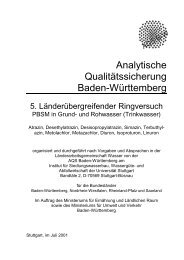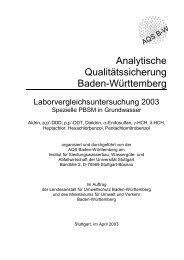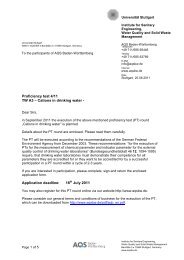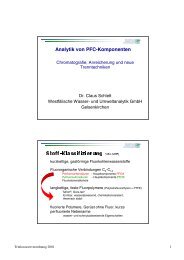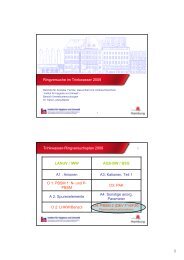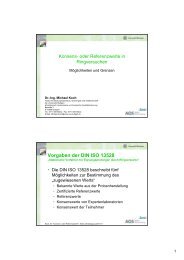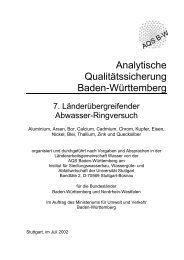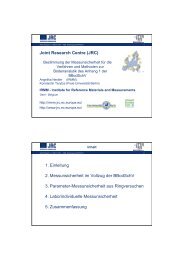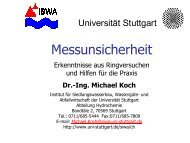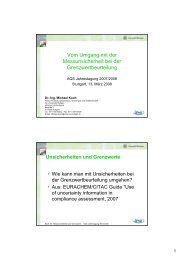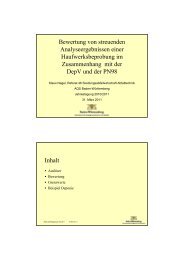Institute for Sanitary Engineering, Water Quality and Solid Waste ...
Institute for Sanitary Engineering, Water Quality and Solid Waste ...
Institute for Sanitary Engineering, Water Quality and Solid Waste ...
Create successful ePaper yourself
Turn your PDF publications into a flip-book with our unique Google optimized e-Paper software.
Chair of <strong>Sanitary</strong> <strong>Engineering</strong> <strong>and</strong> <strong>Water</strong> Recycling<br />
The sewage system consisting of a trickling filter treatment<br />
plant (ca. 130.000 PT), the sewage draining system,<br />
i.e. sewage transport network <strong>and</strong> storm water<br />
treatment facilities, is fed with municipal <strong>and</strong> industrial<br />
waste water (the latter mainly indirectly discharged by<br />
a paper mill). To meet the challenges of project the<br />
following steps have to be accomplished:<br />
• collection <strong>and</strong> analysis of data <strong>and</strong> samples from<br />
the waste water treatment plant, especially evaluation<br />
of the operational journals <strong>and</strong> the continuous<br />
online-measurement data of the biological<br />
treatment stage (trickling filter)<br />
• collection of meteorological data<br />
• set-up of the online measurement (e.g. COD,<br />
NH 4+<br />
, NO 3-<br />
)<br />
• extensive collection <strong>and</strong> analysis of data <strong>and</strong><br />
samples from the indirect discharger (paper mill),<br />
e.g. basic waste water flows <strong>and</strong> waste water quality<br />
dependent on various conditions like paper<br />
grade or internal process impacts)<br />
• analysis of the existing sewage network, e.g. surveying<br />
hydraulic conditions of the sewers <strong>and</strong> respective<br />
facilities<br />
• calculation of relevant sewage network flow times,<br />
utilisation ratios of sewers, hydrostatic water levels<br />
<strong>and</strong> flows under dry weather <strong>and</strong> storm weather<br />
conditions<br />
• design, calibration <strong>and</strong> verification of an integrated<br />
dynamic simulation model<br />
• installation of structural measures concerning the<br />
control facilities of the storm water treatment, the<br />
indirect discharger <strong>and</strong> the sewage network<br />
• application of the simulation model <strong>and</strong> coupling<br />
with the online measurement <strong>and</strong> control facilities<br />
With the help of these measures the municipal waste<br />
water treament plant is likely to continuous operation<br />
in optimal range. The risk of concentration <strong>and</strong> dirt<br />
load peaks polluting receiving waters is avoided or minimised.<br />
By a sophisticated discharge control of the<br />
industrial waste water point sources <strong>and</strong> the control<br />
of the sewage system facilities based on the continuous<br />
model <strong>and</strong> online measurement in<strong>for</strong>mation on<br />
the free storage capacity of the sewage network <strong>and</strong><br />
storm water treatment facilities in dependence on the<br />
present hydraulic situation (dry weather flow, storm<br />
weather flow) as well as on the current state of the<br />
municipal waste water treatment plant, an optimal<br />
quantitative <strong>and</strong> qualitative (head parameter = chemical<br />
oxygen dem<strong>and</strong> [COD]) feed to the treatment<br />
plant is achieved. Thus, long-term an improvement of<br />
the water quality without the necessity of expensive<br />
new investments in advanced treatment stages can be<br />
expected.<br />
Financing Institution:<br />
Ministry <strong>for</strong> the environment Baden-Württemberg<br />
Project Partner:<br />
University of Stuttgart, Germany<br />
City of Heidenheim<br />
Voith Paper Technology Center (Heidenheim)<br />
Contact:<br />
Dipl.-Ing. Ralf Minke, AOR<br />
Dipl.-Ing. C. Meyer<br />
Dipl.-Ing. S. Schmidt<br />
NASSY: laboratories <strong>and</strong> holiday camps <strong>for</strong> female<br />
pupils<br />
The project „Nassy: laboratories <strong>and</strong> holiday camps <strong>for</strong><br />
female pupils“, has been put out <strong>for</strong> tender as a part of<br />
the project “researching pupils – insights into sciences<br />
<strong>and</strong> engineering” by the ministry <strong>for</strong> sciences, research<br />
<strong>and</strong> arts <strong>and</strong> has been benefitted <strong>for</strong> 18 months. The<br />
research centre <strong>for</strong> water in Stuttgart (wfz) under the<br />
aegis of the organization VEGAS has applied <strong>for</strong> the<br />
project which is run by three chairs of the institutes <strong>for</strong><br />
water engineering (IWS <strong>and</strong> ISWA).<br />
The aim of Nassy is to acquaint female pupils from<br />
primary <strong>and</strong> secondary school with physical issues,<br />
sciences <strong>and</strong> engineering by the medium water. The<br />
variety of topics based on water is large <strong>and</strong> has the<br />
advantage, that the pupils can associate their own<br />
everyday experiences.<br />
The Nassy-courses shall inspire the pupils to get interested<br />
in a scientific or engineering occupation. This<br />
can be realized through the inductive practices of working<br />
out the scientific laws on the basis of exciting experiments<br />
<strong>and</strong> excursions as well as through the exemplary<br />
function of experienced female engineers.<br />
The project includes the three components:<br />
1. experimental afternoons<br />
2. holiday camps<br />
3. in<strong>for</strong>mation about study <strong>and</strong> employment<br />
The three technical contents of the components 1 <strong>and</strong><br />
2 were developed by the three chairs of the two institutes<br />
<strong>and</strong> are offered in three thematic modules:<br />
Module I:<br />
drinking water production <strong>and</strong> groundwater,<br />
Module II:<br />
wastewater treatment <strong>and</strong> drinking water purification,<br />
Module III:<br />
surface water <strong>and</strong> hydropower.<br />
56




